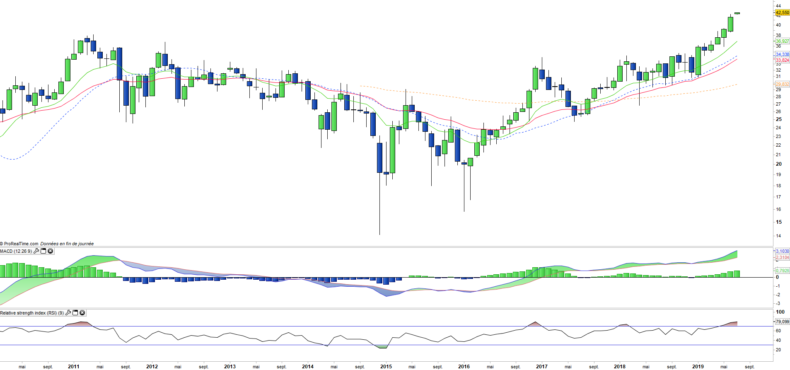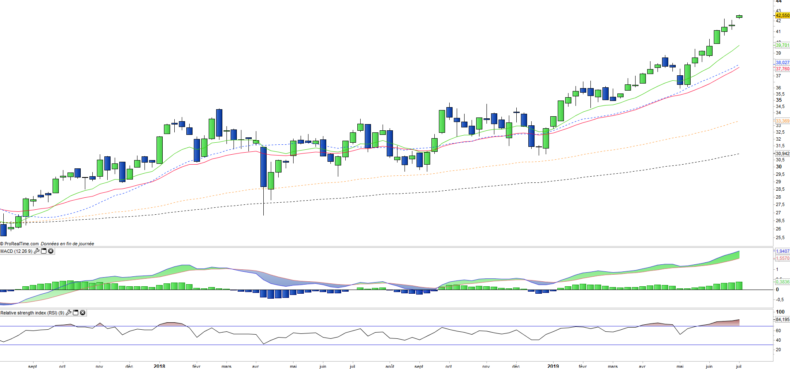Lyxor ETF Russia (RUS) - 02/07/19
Short Term trend: Positive (90/100)
Long Term trend: Positive (100/100)
Scores computed by our proprietary algorithms - cf methodology
Characteristics of the ETF
The ETF Lyxor RUS (Russia), created in 05/2007, is listed in Euro on Euronext and seeks to replicate the Dow Jones Russia GDR $ index consisting of 18 Russian stocks.
The Dow Jones Russia GDR Index is an index that measures the performance of 85% of GDRs (very close to ADRs, an instrument of listing abroad for a non-US or UK company) traded on the London Stock Exchange, with the largest floating capitalization. The index is weighted by the free-float capitalization of each GDR.
The expenses of this ETF are 0.65% and the AUM of approximately 391M€. Replication is indirect (via Swap) and there is a policy of capitalization of dividends.
Alternative ETFs: RSX ( vaneck Vector in USD), ERUS ( iShares in USD)
Index profile
The ETF RUS is made up of only 18 companies, so it is very narrow compared to other national indices.
However, the Russian index is fairly representative of the country's economy, highly concentrated on energy, whose weighting is about 64% due to the presence of the giants Gazprom, Loukoil and Rosneft, while the banking sector accounts for 18% including two large banks, Sberbank and VTB Bank, the remaining 18% are divided between mining companies and industrial companies (consumer goods and technology).
Over the past 10 years, the performance of the Russian index has been negative, which is due to the fall in oil prices and the Western sanctions following the annexation of the Crimea. The Russian economy is at about the same level as Spain, with a GDP of about $ 1200 billion, a diversified economy based on raw materials (gas, oil, minerals, diamonds), and mainly European exports, as well as domestic consumption, which tends to increase gradually, while industry employs nearly 30% of the population, mainly in the chemical, metallurgical and defense sectors.
By 2015, Russia has sunk into the crisis that began in 2014, mainly because of the fall in oil prices that weighs on hydrocarbon revenues, even though non-oil revenues are penalized by weak activity and sanctions that continue to impact the economy. The situation deteriorated in 2015, with the economy entering recession (-3.8%). Inflation continued to rise and a banking crisis hit more than 70 Russian banks, as a result the country's financial reserves melted, the budget deficit widened and the volatility of the ruble worsened.
This context continued in 2016 while at the same time easing somewhat (-0.6%), with private consumption, the main driver of activity, remaining constrained.
Russia has emerged from the recession in 2017, but it is not due to virtually non-existent reforms and the challenges remain: lack of competitiveness, under-investment, low production capacity, dependence on raw materials, poor business climate, lack of structural reforms, aging population and authoritarian drift of Vladimir Putin. Russia is currently enjoying a lull with the recovery of oil prices around $ 60 after the agreement with OPEC and a stabilization of supply.
Russia sees its situation on the external scene improve a little, because of a certain success in Syria, a stabilization of its relations with Europe and a rise of its partnership with China. Russian growth registered a positive momentum in 2019, in line with the better than expected performance in 2018 (+ 2.3%).
Monthly data analysis
The analysis of the monthly data shows an increasingly bullish phase, to the point of returning to the level of the highest historical reached 10 years ago. The corrections are less and less strong and the resistances are erased one by one without there being overheating. The test of the 43/44 € zone is important, because in the event of new highs, the Russian index trend would become really bullish in the long term.
Weekly data analysis
The weekly data chart shows a sharp break in dynamics - upwards - since the strength of the € 35 resistance has been broken. This resulted in a more straightforward increase, with moving averages increasingly on the upside and technical indicators settling in the overbought zone. The prices forcefully arrive on the major resistance, which increases the chances of crossing.
Theme
RUS is a UCITS ETF, listed in EUR, which seeks to replicate the MSCI Russia IMI Select GDR Net Total Return USD Index (18 russian companies)
Characteristics
| Inception date | 20/06/2006 |
| Expense ratio | 0,65% |
| Issuer | Lyxor |
| Benchmark | Dow Jones Russia GDR |
| Ticker | RUS |
| ISIN | LU1923627092 |
| UCITS | Yes |
| EU-SD Status | Out of scope |
| Currence | € |
| Exchange | Euronext Paris |
| Assets Under Management | 391 M€ |
| Replication method | Indirect (swap) |
| Dividend | Capitalization |
| PEA (France) | No |
| SRD (France) | Yes |
| Currency risk | Yes |
| Number of holdings | 18 |
| Risk | 4/5 |
Country breakdown
| Russia | 100% |
Sector Breakdown
| Energy | 64% |
| Financials | 18% |
| Materials | 14% |
| Consumer staples | 3% |
Top ten holdings
| Gazprom | 20% |
| Lukoil | 18% |
| SberBank | 17% |
| Novatek | 10% |
| Tatneft | 10% |
| MMC Norilsk Nickel | 7% |
| Rosneft | 4% |
| Magnit | 3% |
| Severstal | 2% |
| Novolipet Steel | 2% |


